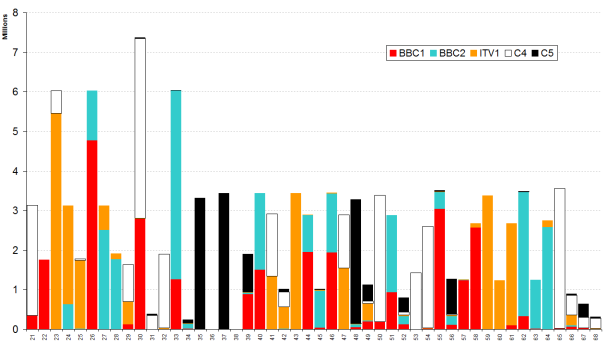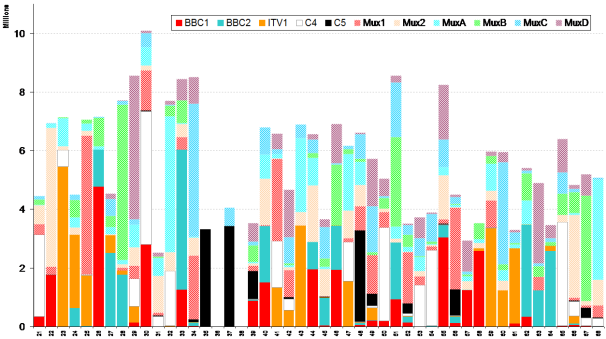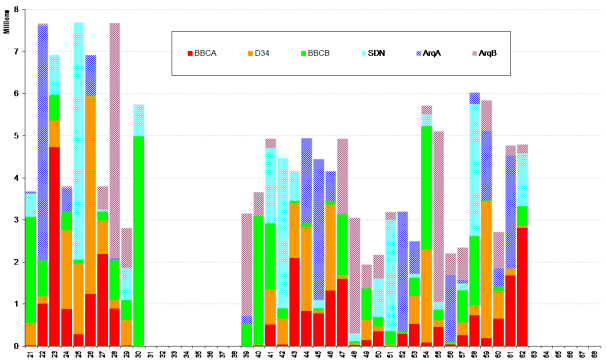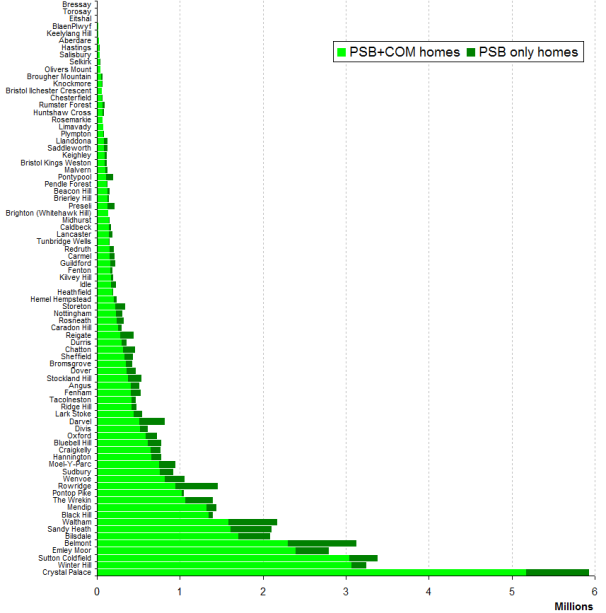The commercial multiplex after switchover: ArqA, ArqB and SDN
 Brian Butterworth published on UK Free TV
Brian Butterworth published on UK Free TV At a significant, but minority, of transmitter sites, the three commercial multiplexes, and in particular ArqA and ArqB are often held at low power for many months following the digital switchover.
The old analogue network
The following graph shows the allocation of the old analogue networks, in effect on the day before digital TV was first introduced to the UK. Along the bottom is the channel numbers from C21 up to C68, with each network coloured coded and the height of each bar representing the number of homes served.
There are 45 frequencies available (C36 was for RADAR, C38 for radio astronomy). The analogue network needed 10 frequencies per network, so in effect there are "four and a half" analogue networks: Channel 5 has less than 100% coverage.
Some frequencies were allocated exclusively to a network: C22 is used at 114 sites for BBC One analogue to 1,752,564 homes; C59, C60 and C61 at 85, 91 and 96 sites for ITV1 to 3,366,782, 1,232,976 and 2,569,576 homes, C35 and C37 are 12 and 10 Channel 5 analogue sites to 3,314,000 and 3,432,000 homes.
Another use of the frequencies is to divide the coverage into two services, such as C33 where 5 main transmitters serve 4,773,899 homes with analogue BBC TWO, but also 80 relay sites use it for analogue BBC One to 1,254,378 homes.
Finding space for ONdigital
The reason about 10 "total" frequencies are required for each full analogue network is the Inversion Effect - during certain weather conditions the analogue television signals would travel much further than usual as they bounce back to the ground due to a layer in the atmosphere acting like a signal mirror.These generous allocations allowed, back in the 1990s, the planners to provide low power digital services. This is because the system used for encoding the digital services, COFDM, looks like "snow" to an analogue service. Under inversion conditions, if the digital services "leak" to other areas, they will cause a small amount of snow to appear on an analogue picture, and COFDM has a number of systems built into it to reject interference from analogue.

This diagram shows an "analogue view" of the digital services - they appear as "noise" that will degrade an analogue picture by making it snowy.

By accepting that the digital coverage would not match the analogue service, both in terms of the number of transmitters (just 80 main ones), and the power output levels from these transmitters, and also by using carefully calculated radiation patterns (meaning the signal does not broadcast at the same level in all directions), ONdigital was able to provide a service.
Digital switchover
To provide the digital services to all homes in the UK it would then become necessary to close the analogue services and reallocate the frequencies.The diagram below shows how this has been done.

Some frequencies have been reallocated to other purposes - such as C61 to C69 for fourth generation mobile phone services, the so-called "digital dividend". (Note that C61 and C62 are shown as allocated in the diagram as the transmitters using them will be shuffled to C39 and C40 before the 4G services launch, C31-C37 are being returned to digital TV in 2012-15).
In general this means that three of the analogue network plans have been kept, and allocated to the public service broadcasting multiplexes: BBCA, D3+4 and BBCB (which is Freeview HD). This was necessary - it means that these multiplexes remain "in group" at all transmitters, so reception of these is possible without changing an existing aerial.
This means that the space for the three commercial multiplexes SDN, ArqA and ArqB have been reallocated into the effective "gaps". For this reason, the coverage of these multiplexes is much like the three most powerful multiplexes before switchover.
For this reason, whilst the network is being changed between the analogue/digital to digital-only network it is often necessary to keep the power levels for the commercial multiplex on low power, or to assign them to other temporary frequencies.
As you can see from this diagram, the outcome is that most of the main 80 transmitters will provide lower coverage for all services (light green) than they do for just the public service multiplexes (dark green).

Help with Freeview, aerials?
In this section
Saturday, 27 August 2011
M
Mrs Friel6:29 PM
I live in Market Rasen and receive TV signal from Belmont. I did final retune on 17th August and all my TV's updated including excellent HD reception on main set. Today,27th August my small TV continues to receive all channels, but the main set is missing many channels and the HD reception is not consistent. I have tried automatic retune on this new Samsung set and it still fails to pickup the missing channels.
Any advice appreciated. Is East Yorks & Lincs the same as Belmont as that is the area it is tuning to?
| link to this comment |
J
jb388:00 PM
Mrs Friel: Anyone living in Market Rasen is virtually underneath the umbrella of the Belmont mast, and as such liable to be receiving an exceptionally strong signal to the extent of it verging on blocking a sensitive sets tuner.
If you have a set top aerial around try using that to see if that cures the problem, if it does then you will require to purchase a simple attenuator to place in line with your aerial socket.
By the way you should give the set another re-tune with (if available) the set top aerial, this just in case anything was corrupted on the previous re-tune by the signal strength being received on your normal aerial.
(Wouldn't go amiss just to carry out a factory re-tune)
| link to this comment |
Sunday, 28 August 2011
J
JMH1:40 AM
I live at East Leake, Notts (LE12)and can see Waltham mast on the horizon. After 2 or 3 retunes recently I still cannot get ITV channels at more than 1/4 strength, compared to 100% for BBC and the rest.(roof antenna)
QVC on 16 has disappeared completely.
Will this situation change?
| link to this comment |
K
KMJ,Derby7:14 AM
JMH: Yes. Mux2 (ITV1/2 etc) changes to Mux D3+4 at high power on 31st August 2011. A little longer though for QVC, as Mux SDN switches to high power working on 12th October 2011.
| link to this comment |
Saturday, 3 September 2011
M
MuxedUp2:30 PM
Market Rasen
The above article states that "ArqA and ArqB are often held at low power for many months following the digital switchover", but it doesn't explain why that is the case. Surely, now that analogue has gone, Mux's carrying the likes of FilmFour & ITV4 (which I can no longer receive) ought to be able to sustain a stronger signal. Why the delay? And when can we expect their signal strength to be increased?
| link to this comment |
MuxedUp's: mapM's Freeview map terrainM's terrain plot wavesM's frequency data M's Freeview Detailed Coverage
Sunday, 4 September 2011
S
Shane7:56 AM
Warwick
Hi, I recently began switchover in Warwick and looking around was initially puzzled by the seemingly random positioning of TV aerials in my street (at CV34 5LQ) I realise people were confused whether to point at Sutton Coldfield or the closer, yet weaker transmitter at Lark Stoke. (most ignoring Leamington as PSO it will only carry 3 muxes) being in the shadow of a hill I decided to retune to Lark stoke, alerting the polarization of my Televes 45 to vertical. I now have superb reception on all muxes except the one one ch 47, but I am receiving a mux on ch 60. Thinking this was oxford, however this is horizontally polarized and some 30 degrees adrift. Any ideas what may be happening here would be gratefully received!
| link to this comment |
Shane's: mapS's Freeview map terrainS's terrain plot wavesS's frequency data S's Freeview Detailed Coverage
K
KMJ,Derby9:22 AM
Shane: At Lark Stoke MuxArqB is transmitted currently on a temporary frequency, C60, at low power until 28th September 2011. It will use C47 from that date, SDN will use C41+ and Mux ArqA will be on C44, so a retune will be required.
| link to this comment |
Wednesday, 7 September 2011
MuxedUp: Well apart from the very clear "this means that the space for the three commercial multiplexes SDN, ArqA and ArqB have been reallocated into the effective "gaps". For this reason, the coverage of these multiplexes is much like the three most powerful multiplexes before switchover" bit.
| link to this comment |
Nick: I'm sure I went into this at the top of the page with all the graphs.
So, here I go again.
The three PSB multiplexes move (generally speaking) to three of the four analogue channels, at slightly lower power but the same as required to provide the same level of coverage.
The COMs then move into the *OLD* Freeview plan, which means that they are at lower power on some transmitters, as per the graph.
I have no idea what you mean by a "percieved signal quality", the signal strength and robustness (due to being in 8k) is demonstrably improved, I'm not sure what anyone's "perception" has to do with the price of fish.
| link to this comment |
Thursday, 8 September 2011
P
Philip Crack6:35 PM
please could you explain to me why i cant receive film 4 or yesterday channels as i have just erected a brand new mux tri boom aerial expecting to pick up all channels.I live in Kettering Northants and use the Sandy Heath Transmiter.Will i be able to receive these channels at some later date.Thanks for your help.
| link to this comment |
Select more comments
Your comment please!